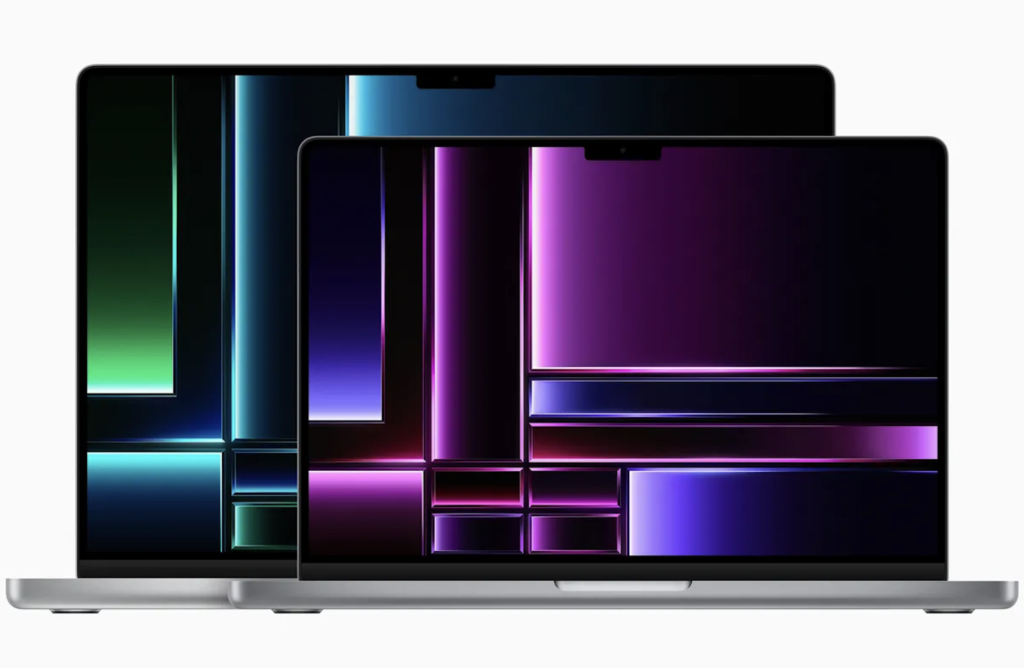New 14- and 16-inch MacBook Pro models with Apple’s newest M2 Pro and Max CPUs have been released. In comparison to the M2 Max, which has up to 38 GPU cores and compatibility for up to 96GB of unified memory, the M2 Pro will ship with a 12-core CPU, a 19-core GPU, and up to 32GB of unified memory.
Starting at $1,999 for the new 14-inch MacBook Pro with M2 Pro and $2,499 for the 16-inch variant. Both are currently available for purchase online, and on January 24th, they will begin shipping and becoming accessible in Apple shops.
According to Apple, the M2 Pro features approximately 20% more transistors than the M1 Pro and twice as many as the M2 shipped with. Additionally, it offers 200GB/s of unified memory bandwidth, which is twice as fast as that of the standard M2. With all of this capability, programmes like Adobe Photoshop and Xcode ought to run more smoothly. According to Apple, the MacBook Pro with the M2 Pro “processes photos in Adobe Photoshop up to 40% faster than with the M1 Pro, and up to 80% faster than the MacBook Pro with an Intel Core i9 processor.”
The M2 Max chip, like the M1 Max, increases the GPU power even farther despite having the same 12-core CPU as the M2 Pro. The M2 Max, according to Apple, is up to 30% quicker in graphics than the M1 Max and can “address graphics-intensive projects that competitor systems couldn’t even execute.”
The 16-inch model, according to Apple, has the “longest battery life ever in a Mac,” with an M2 Pro, it can run for up to 22 hours of video playback or 15 hours of wireless web browsing. The earlier M1 Pro model, which Apple also claimed had the longest battery life ever, is an hour longer according to both assessments. Because of the company’s very specific battery life tests, we were dubious about that promise at first. However, after using it, we received a score of 16 hours, which was then our best result ever.
According to Apple, the 14-inch device will have a battery life of up to 18 hours of movie playback and 12 hours of browsing, which is an hour longer than the previous model. Although the 14-inch has a considerably better screen and will probably be significantly more powerful, it still doesn’t last as long as its estimates for the 13-inch Pro with its ordinary M2 CPU (which lasted so long that it actually stressed out my laptop-reviewing colleague Monica Chin).
Additionally, Wi-Fi 6E and a “more powerful HDMI” (likely HDMI 2.1) that allows 8K displays up to 60Hz and 4K displays up to 240Hz are now features of the most recent MacBook Pro models.
The new MacBook M2 Pro and Max models were not announced at a press event, but Apple did release a 19-minute YouTube video that is essentially the same thing. Although Tim Cook, the CEO of Apple, is not featured in the movie, it was shot at the company’s headquarters at Apple Park and includes other Apple engineers. The video below contains the complete announcement, which also features the new M2 Mac Mini.
Both the new MacBook M2 Pro and M2 Max replace previous iterations that have been in use since the latter half of 2021. It’s good to see Apple update its Apple silicon processors on a regular basis, even though they’re still excellent values (worth bearing in mind as stores start to try and sell older versions in favour of the new ones).
The M1 Pro and M1 Max CPUs, which were used in Apple’s most recent MacBook Pro models, have a maximum of a 10-core CPU, 32-core GPU, and 16-core Neural Engine, as well as capability for 64GB of memory and an 8TB SSD.
Apple first made the next-generation M2 chip available in the 13-inch MacBook Pro and lower-end MacBook Air models rather than the 14- and 16-inch MacBook Pros. These laptop CPUs employed 25% more transistors than the M1 and had improved performance and efficiency cores, larger cache, and higher memory bandwidth.
The M1 Pro and Max models surpassed the revised lower-end variants in benchmarks despite having older hardware. Of course, this hasn’t prevented people from wondering what high-end CPUs with Apple’s newest architecture will look like. When it unveiled the M2, Apple claimed the chips would deliver an 18% faster CPU and a 35% faster GPU than the original M1.




